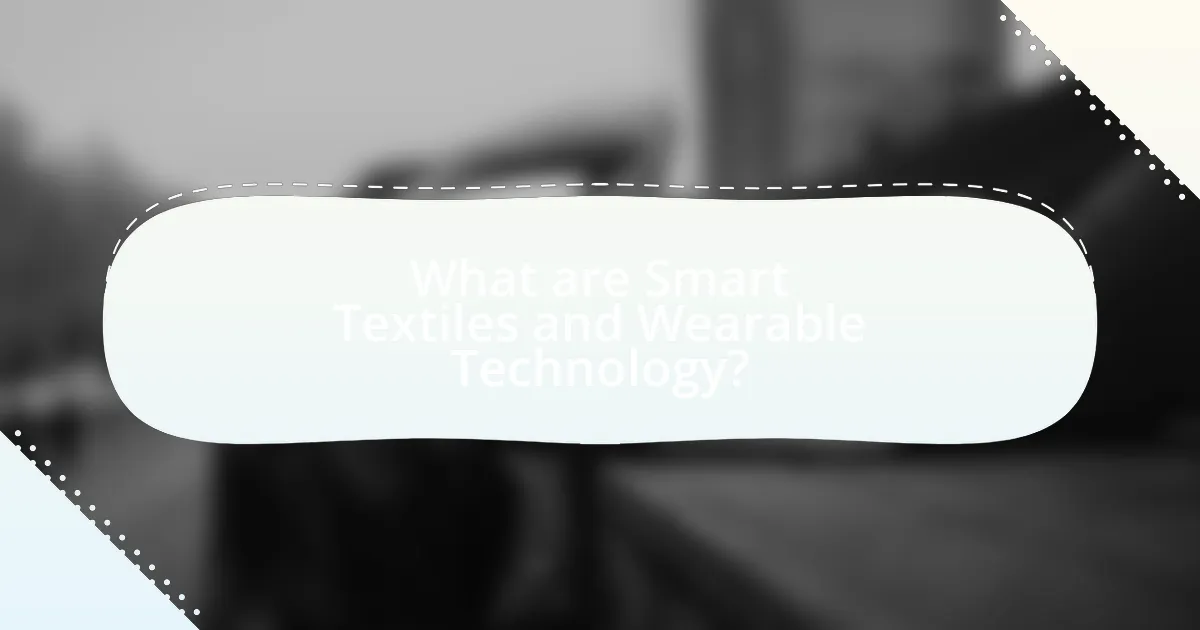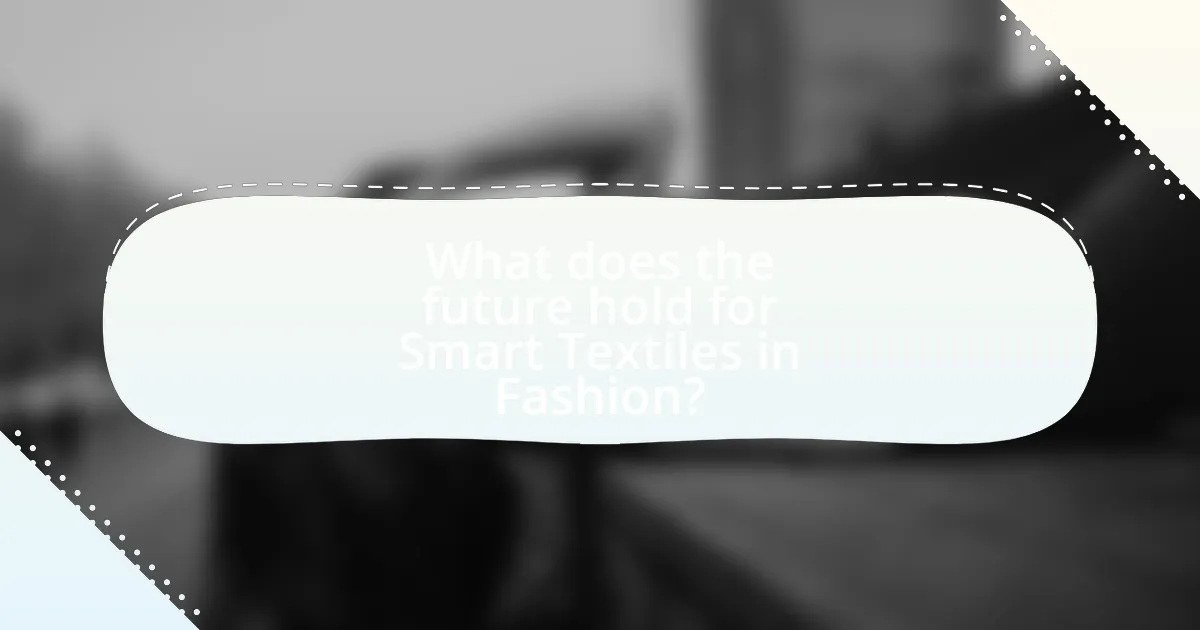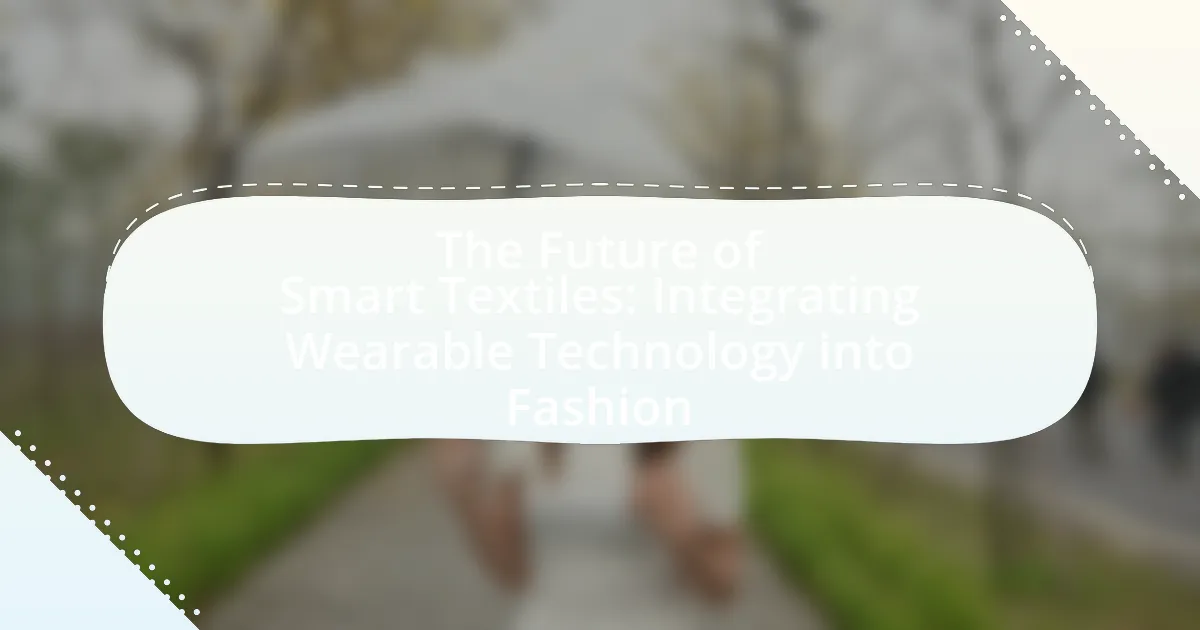Smart textiles are innovative fabrics embedded with technology that allows them to sense and respond to environmental stimuli, while wearable technology refers to electronic devices worn on the body that often integrate with these textiles. This article explores the integration of smart textiles and wearable technology in the fashion industry, highlighting their functionalities such as health monitoring, user feedback, and enhanced user experience. Key topics include the differences between smart textiles and traditional fabrics, the technologies involved, current trends, challenges faced by designers, and the future potential of these advancements in everyday life, sports, and health. The discussion emphasizes the growing consumer demand for multifunctional apparel and the impact of sustainability on the development of smart textiles.

What are Smart Textiles and Wearable Technology?
Smart textiles are fabrics embedded with technology that enables them to sense and respond to environmental stimuli, while wearable technology refers to electronic devices worn on the body that often integrate with smart textiles. These innovations allow for functionalities such as monitoring health metrics, providing feedback, and enhancing user experience in various applications, including fitness, healthcare, and fashion. For instance, smart textiles can include sensors that track heart rate or temperature, and wearable technology can encompass devices like smartwatches or fitness trackers that collect and analyze data. The integration of these technologies is transforming the fashion industry by creating garments that are not only stylish but also functional and interactive.
How do smart textiles differ from traditional fabrics?
Smart textiles differ from traditional fabrics primarily in their ability to interact with the environment and respond to stimuli. While traditional fabrics are static and serve basic functions such as covering and protection, smart textiles incorporate technology that enables features like sensing, communication, and energy generation. For instance, smart textiles can monitor physiological signals, adjust temperature, or even change color based on external conditions, showcasing their multifunctionality. This integration of electronics and textiles allows for applications in health monitoring, sports performance, and fashion innovation, marking a significant advancement over conventional materials.
What technologies are integrated into smart textiles?
Smart textiles integrate various technologies, including sensors, conductive fibers, and microcontrollers. Sensors enable the monitoring of physiological parameters such as heart rate and temperature, while conductive fibers facilitate the transmission of electrical signals. Microcontrollers process data and enable communication with external devices, enhancing functionality. For instance, research published in the journal “Textile Research Journal” highlights the use of piezoelectric materials in smart textiles for energy harvesting, demonstrating the diverse technological applications in this field.
How do smart textiles enhance functionality in clothing?
Smart textiles enhance functionality in clothing by integrating technology that allows garments to respond to environmental stimuli and user needs. These textiles can monitor physiological parameters such as heart rate and temperature, providing real-time feedback to the wearer. For instance, a study published in the journal “Advanced Functional Materials” demonstrates that smart textiles can change their properties based on moisture levels, improving comfort and performance in athletic wear. Additionally, smart textiles can incorporate features like embedded sensors and conductive fibers, enabling functionalities such as communication and data collection, which further enhances the utility of clothing in various contexts, from sports to healthcare.
What role does wearable technology play in fashion?
Wearable technology plays a transformative role in fashion by merging functionality with aesthetics, allowing garments to monitor health metrics, enhance user experience, and provide connectivity. This integration of technology into clothing enables features such as fitness tracking, temperature regulation, and even notifications through smart textiles. For instance, the global smart clothing market is projected to reach $5.3 billion by 2025, highlighting the growing consumer demand for functional fashion. Additionally, brands like Levi’s and Google have collaborated to create smart jackets that allow users to control their devices through gestures, demonstrating the practical applications of wearable technology in everyday fashion.
How has wearable technology evolved in the fashion industry?
Wearable technology in the fashion industry has evolved significantly from basic fitness trackers to sophisticated smart textiles that integrate seamlessly into everyday clothing. Initially, wearable devices focused on health and fitness metrics, such as heart rate and step counting, exemplified by products like the Fitbit launched in 2009. Over time, advancements in materials and technology have led to the development of garments that not only monitor health but also enhance user experience through features like temperature regulation, moisture management, and even connectivity to smartphones. For instance, brands like Ralph Lauren and Levi’s have introduced smart clothing that can track biometric data and interact with mobile applications, showcasing the integration of fashion with functional technology. This evolution reflects a growing consumer demand for multifunctional apparel that combines style with utility, indicating a trend towards a more interconnected and technologically advanced fashion landscape.
What are the key benefits of integrating wearable technology into fashion?
Integrating wearable technology into fashion offers enhanced functionality, improved user experience, and increased personalization. Wearable technology, such as smartwatches and fitness trackers, allows users to monitor health metrics, receive notifications, and interact with their environment seamlessly. For instance, a study by the International Data Corporation reported that the global wearables market is expected to reach $60 billion by 2025, indicating a growing consumer demand for tech-integrated apparel. Additionally, fashion brands can leverage data collected from wearables to tailor products to individual preferences, thereby enhancing customer satisfaction and loyalty.

What are the current trends in Smart Textiles and Wearable Technology?
Current trends in smart textiles and wearable technology include the integration of health monitoring features, advancements in fabric technology, and increased focus on sustainability. Health monitoring features, such as heart rate and activity tracking, are becoming standard in wearables, with devices like smartwatches and fitness trackers utilizing sensors embedded in textiles. Advancements in fabric technology, including the development of conductive fibers and flexible electronics, enable garments to interact with digital devices seamlessly. Additionally, sustainability is gaining traction, with brands prioritizing eco-friendly materials and production methods, reflecting a growing consumer demand for environmentally responsible fashion. These trends are supported by market research indicating a projected growth of the wearable technology market, expected to reach $60 billion by 2023, highlighting the increasing consumer interest and investment in this sector.
How are designers incorporating smart textiles into their collections?
Designers are incorporating smart textiles into their collections by integrating materials that can respond to environmental stimuli, such as temperature, moisture, and light. For instance, brands like Ralph Lauren have developed shirts that can monitor heart rate and other biometric data through embedded sensors. Additionally, companies like Adidas are utilizing textiles that change color based on temperature, enhancing both functionality and aesthetic appeal. This integration of technology not only elevates the performance of garments but also aligns with consumer demand for innovative and multifunctional fashion.
What are some examples of successful smart textile fashion lines?
Successful smart textile fashion lines include Wearable X, which integrates technology into activewear for enhanced performance, and Levi’s Commuter Trucker Jacket, featuring built-in touch-sensitive technology for smartphone connectivity. Another example is the collaboration between Ralph Lauren and the University of Massachusetts, which produced a smart shirt that monitors biometric data. These lines demonstrate the effective integration of technology into fashion, enhancing functionality while maintaining style.
How do consumer preferences influence smart textile trends?
Consumer preferences significantly influence smart textile trends by driving demand for functionality, sustainability, and aesthetics. As consumers increasingly prioritize comfort and convenience, manufacturers are responding by developing textiles that offer features such as moisture-wicking, temperature regulation, and integrated technology for health monitoring. For instance, a survey by McKinsey & Company found that 67% of consumers consider sustainability when making fashion purchases, prompting brands to innovate with eco-friendly materials and production processes. This shift in consumer values directly shapes the direction of smart textile development, leading to a market that increasingly aligns with consumer expectations for both performance and environmental responsibility.
What challenges do designers face when integrating smart textiles?
Designers face several challenges when integrating smart textiles, including technical limitations, cost constraints, and user acceptance. Technical limitations arise from the complexity of combining electronic components with traditional fabrics, which can affect the garment’s comfort and functionality. Cost constraints are significant, as the materials and technology involved in smart textiles often lead to higher production costs, making it difficult to achieve market viability. User acceptance is another challenge, as consumers may be hesitant to adopt wearable technology due to concerns about privacy, usability, and the perceived value of smart textiles compared to conventional clothing. These challenges highlight the need for ongoing research and development to create effective, affordable, and user-friendly smart textile solutions.
What are the technical limitations of current smart textiles?
Current smart textiles face several technical limitations, including durability, comfort, and power supply issues. Durability is a significant concern, as many smart textiles are not resistant to wear and tear, leading to a shorter lifespan compared to traditional fabrics. Comfort is another limitation; integrating electronic components can make garments less breathable and heavier, which affects wearability. Additionally, power supply challenges arise because many smart textiles require batteries or energy sources that can be cumbersome or impractical for everyday use. These limitations hinder the widespread adoption and functionality of smart textiles in the fashion industry.
How do cost and accessibility impact the adoption of smart textiles?
Cost and accessibility significantly hinder the widespread adoption of smart textiles. High production costs associated with advanced materials and technology make smart textiles expensive for consumers, limiting their market reach. For instance, a study by the European Commission in 2020 indicated that the average price of smart textiles can exceed 100 euros per item, which is prohibitive for many potential users. Additionally, limited availability in retail outlets restricts consumer access, as many smart textiles are primarily sold online or in specialized stores, further reducing their adoption.

What does the future hold for Smart Textiles in Fashion?
The future of smart textiles in fashion is poised for significant growth, driven by advancements in technology and increasing consumer demand for functionality and personalization. Innovations such as conductive fibers, sensors, and microcontrollers are enabling garments to monitor health metrics, adapt to environmental conditions, and enhance user experience. According to a report by Research and Markets, the global smart textiles market is expected to reach $5.3 billion by 2024, growing at a CAGR of 27.4% from 2019. This growth is fueled by applications in sports, healthcare, and everyday wear, indicating a strong trend towards integrating wearable technology into fashion.
How will advancements in technology shape smart textiles?
Advancements in technology will significantly shape smart textiles by enhancing their functionality, comfort, and integration with digital devices. Innovations such as conductive fibers, flexible sensors, and advanced materials enable textiles to monitor health metrics, respond to environmental changes, and interact with smartphones. For instance, research from the University of California, Berkeley, demonstrates that integrating nanotechnology into fabrics can create textiles that change color or temperature based on external stimuli. This evolution not only improves user experience but also expands applications in healthcare, sports, and fashion, making smart textiles more versatile and appealing to consumers.
What emerging technologies are expected to influence smart textiles?
Emerging technologies expected to influence smart textiles include advanced materials, IoT integration, and artificial intelligence. Advanced materials such as conductive fibers and phase-change materials enhance the functionality of textiles by enabling features like temperature regulation and moisture management. IoT integration allows smart textiles to connect with devices, facilitating real-time data collection and communication, which is crucial for applications in health monitoring and fitness tracking. Artificial intelligence enhances the adaptability of smart textiles by enabling them to learn user preferences and optimize performance accordingly. These technologies collectively drive innovation in the smart textiles sector, as evidenced by the increasing number of patents and research publications focused on these advancements.
How might sustainability impact the future of smart textiles?
Sustainability will significantly influence the future of smart textiles by driving the development of eco-friendly materials and production processes. As consumer demand for sustainable products increases, manufacturers will prioritize biodegradable fabrics and low-impact manufacturing techniques, reducing environmental harm. For instance, the global market for sustainable textiles is projected to reach $8.25 billion by 2027, indicating a strong shift towards environmentally responsible practices. This trend will not only enhance the appeal of smart textiles but also align them with broader sustainability goals, such as reducing waste and carbon footprints in the fashion industry.
What are the potential applications of smart textiles in everyday life?
Smart textiles have numerous potential applications in everyday life, including health monitoring, sports performance enhancement, and fashion innovation. For instance, smart textiles can be integrated into clothing to monitor vital signs such as heart rate and body temperature, providing real-time health data to users and healthcare providers. In sports, these textiles can enhance performance by tracking movement and providing feedback on technique, which can lead to improved training outcomes. Additionally, in the fashion industry, smart textiles can enable garments to change color or pattern based on environmental conditions or user preferences, creating dynamic and personalized clothing options. These applications demonstrate the versatility and transformative potential of smart textiles in enhancing daily living experiences.
How can smart textiles improve health and wellness?
Smart textiles can improve health and wellness by enabling continuous monitoring of physiological parameters such as heart rate, temperature, and muscle activity. These textiles incorporate sensors that collect real-time data, allowing for personalized health insights and timely interventions. For instance, a study published in the journal “Nature” demonstrated that smart textiles could detect early signs of health issues, leading to proactive healthcare measures. Additionally, smart textiles can enhance physical rehabilitation by providing feedback on movement and posture, which has been shown to improve recovery outcomes in patients.
What role can smart textiles play in sports and fitness?
Smart textiles play a crucial role in sports and fitness by enhancing performance monitoring and improving athlete comfort. These textiles incorporate sensors that track metrics such as heart rate, body temperature, and muscle activity, providing real-time data to athletes and coaches. For instance, a study published in the journal “Sensors” highlights that smart textiles can reduce injury risk by monitoring biomechanical parameters during training sessions. Additionally, smart textiles can adapt to environmental conditions, offering moisture-wicking and temperature-regulating properties, which further enhance the athlete’s experience.
What best practices should designers follow when creating smart textiles?
Designers should prioritize user comfort and functionality when creating smart textiles. This involves selecting lightweight, breathable materials that allow for ease of movement while integrating technology seamlessly. Additionally, designers must ensure that the electronic components are durable and washable, as evidenced by research indicating that textiles must withstand multiple wash cycles without losing functionality. Furthermore, incorporating user feedback during the design process can enhance usability and satisfaction, as studies show that user-centered design leads to better adoption rates of wearable technology. Lastly, designers should stay informed about advancements in materials science and technology to leverage innovative solutions that enhance the performance and appeal of smart textiles.

Leave a Reply